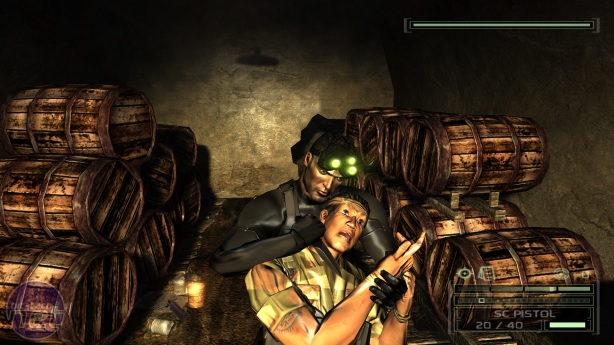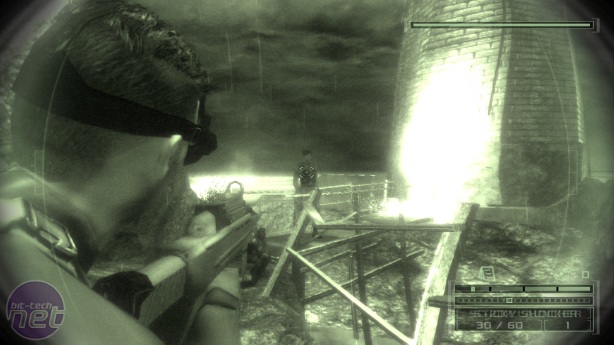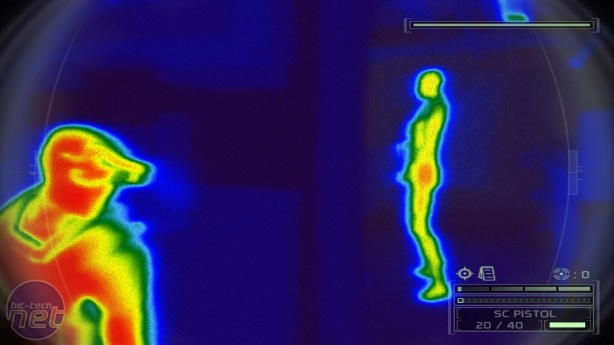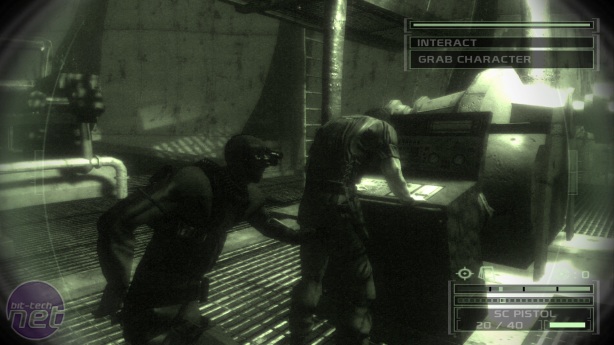
Ten Years On: Splinter Cell: Chaos Theory
I've always found something a little odd about Splinter Cell: Chaos Theory. It isn't the embarrassingly obvious product placement of Airwaves chewing gum in every other cutscene, or the general absurdity that nobody ever notices a middle-aged man with three green lights on his head sneaking around the high-security buildings they're patrolling. It's that the big new feature that Ubisoft hinged the game's success upon - placing it on the front of the box and touting it at every PR opportunity - was a combat knife.
I remember thinking this strange at the time of release, and after ten years it isn't any less so. This is Sam Fisher we're talking about, the most gadget-fixated sneaky bastard in videogame history. He's equipped with enough tech to give James Bond an inferiority complex; a rifle that can fire a half-dozen different projectiles, vision-enhancement goggles with three settings, and a pistol that can remotely disable any electronic device (I suppose any pistol can technically do this, but Sam's can do it sans bullets). And yet Ubisoft sold Chaos Theory to us on basis that he wields a bit of pointy metal. It's a little like Apple selling us the latest iPhone based on its functionality as a paperweight.
But it gets weirder because when you actually play Chaos Theory, the knife doesn't really do that much. Sure, Sam uses it all the time; for interrogating a guard, cutting through fabric, breaking a lock, and occasionally dispatching an opponent. But all of these are context-sensitive actions. The knife is never mechanically active in the world as it might be in games like Dishonored or Skyrim. Fisher could easily perform these actions without the knife. It's the gimmickiest of videogame gimmicks.
I don't say this as a criticism of Chaos Theory, or to mock Ubisoft's marketing strategy (the game sold 2.5 million copies in its first month, so clearly the added edge didn't hurt). Rather, the superfluous nature of Fisher's knife hints at what makes Chaos Theory such a fantastic stealth game, because it isn't that. Neither is it any of Fisher's other equipment. You could take away the guns, the goggles, the gadgetry, and you'd still be left with something quite remarkable.
Chaos Theory's greatness lies much further beneath its skin. There's no standout feature or system that can take responsibility for elevating Chaos Theory above all the other Splinter Cell games, and indeed the majority of stealth games. Rather, it's a complex network of different design inputs, all woven together to create one exquisite whole.
Some of these I remembered well before returning to the game over Easter, foremost amongst which is the level design and the concepts behind them. Whether it's sneaking through the caves of a South American guerrilla encampment or hopping across Manhattan rooftops to break into a computer hacker's New York apartment, Chaos Theory's missions are all so expertly crafted. Two have always stood out in my mind - the mission the cargo ship, and the following bank heist.
The former is a fascinating setting for a stealth mission because there are so few places to hide on a ship, even one as big as Sam's target. Yet such a daunting task is no trouble for Sam Fisher, and the designers make you feel exceptionally clever at keeping yourself concealed, always giving just enough wiggle-room to slip past guard patrols. Indeed, I was slightly surprised by the structure of the missions upon returning to them. They're far more linear than I recall, constantly funneling you toward an objective. Occasionally there's a room or corridor you can explore if you like, but the emphasis is much more on getting past your opponents than around them. As for the bank heist, I enjoy that for a much simpler reason; robbing a bank as Sam Fisher is a really cool idea.
All the missions are exceptionally well designed, and populated by some impressive AI guards. I don't recall the game's guards and henchmen being anything like as <i>sharp</i> as they are. I knew I'd arouse their suspicions by switching or shooting a light, or if they stumbled upon a body. But I'd forgotten they'll also start searching the area if you leave a door open when it was closed, or even switch off a computer screen after using it. Much of this is illusory. The guards usually have small patrol vectors, meaning they only need to respond to a limited number of potential scenarios. But game AI is always illusory, and Chaos Theory's is no less convincing for that.

MSI MPG Velox 100R Chassis Review
October 14 2021 | 15:04













Want to comment? Please log in.